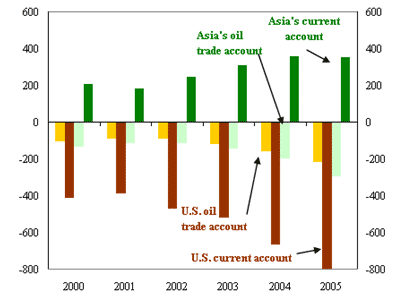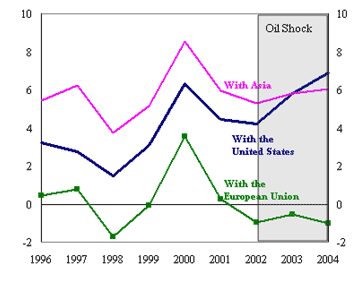Reality-based analysis of the oil exporters’ contribution to an unbalanced world
More on:
I am not a big fan of arguments not well grounded in data.
Like the now immensely outdated argument that China's bilateral surplus with the US is offset by bilateral deficits elsewhere. Right now China runs a significant ($100b) trade surplus with the world. And its current account surplus is about as big (relative to its GDP) as the United States' deficit.
Or the argument that the US trade deficit is growing because the world isn't growing. World growth was very, very strong in 2004 and 2005.
Or the argument that the US serves as an offshore intermediary for Chinese savings. That might make sense if China had deposited $200b in the US, financing $200b in US FDI in China. But it doesn't make much sense when China's official deposits in the US are at least $540b, and probably more, and US FDI in China is around $60b. Even some US FDI flows through Hong Kong, i think it is pretty clear that Chinese savings it not financing US FDI in China. Chinese savings is financing the construction of US suburban housing - and home equity lines that allow America to keep its consumption up.
But for all the attention paid to China, the biggest pool of spare savings is found not in Asia, but in countries sitting on large underground resevoirs of black gold. The combined current account surplus of the world's oil exporters is immense. It is quite likely -- no one really knows because of data issues -- that the oil exporters collectively have displaced China's central bank as the largest source of financing for the US current account deficit. And outgunning a country whose reserves increased by $250b (adjusted for valuation) isn't easy.
The IMF has access to more data than anyone else. And Saleh Nsouli of the IMF's Paris office puts it to good use. I cannot think of a better assessment of how surging oil prices have influenced the global balance of payments.
Nsouli highlights how oil exporters now have about as large a savings (current account) surplus as Asia.
"While Asia's current account surplus is projected to have risen to US$341 billion in 2005 (equivalent to 47 percent of the United States' current account deficit), that of oil exporters is projected to have reached US$296 billion (equivalent to 41 percent of the United States' current account deficit). Relative positions are expected to reverse in 2006. According to IMF projections, oil exporters' current account surplus would amount to 46 percent of the U.S. deficit in 2006, while the figure for Asia would drop to 41 percent."
That data suggests to me that the oil exporters have a big role to play in global adjustment. The FT reports that the IMF's forthcoming WEO will make the same point. Yet this is something that has yet to be fully reflected in the rethoric of Rodrigo de Rato, the IMF's Managing director. His latest speech recognizes that oil savings have surged, contributing to our imbalanced world. But his trinity of proposed solutions is conventional- more savings in the US, less in Asia and more economic flexibility in Europe. Yet the conventional list of sort of leaves the oil exporters out. That is a mistake.
As Nsouli notes, large savings surpluses in the oil exporters often are the product of government policies, not private decisions.
What are oil exporters doing with the extra oil revenue? Given the large government share in the oil sector in most oil-exporting countries, and thus in oil revenue, the deployment of the additional oil income is mainly the decision of governments. In many cases, in particular in the Middle East and Africa, these have adopted conservative assumptions on the path of oil prices in their budgets, much below market prices, and little of the excess revenue from oil exports is estimated to have been spent.
I realize that it is important to build up buffers v. oil price volatility. But I don't see why bigger buffers are the only tool oil exporters are using to manage oil price volatility. A bit of exchange rate flexibility would help too. Ask Canada.
Nsouli also makes another point - one that I tried to make on Monday, but perhaps not as elegantly. The rise in the surplus of the oil exporters has not been accompanied by a fall in the surplus of oil-importing Asia.
This graph - plucked from Nsouli -- tells the story better than any words:
Oil trade and global imbalances
(in billion of U.S. dollars)

Note the deterioration - as one would expect - in Asia's oil balance (the light blue bar). And note that this deterioration hasn't been matched by a deterioration in Asia's overall current account surplus (the green bar). Note that the deterioration in the United States' overall current account exceeds the deterioration in its oil trade account. That is because Asia's overall surplus with the US is rising - a point well illustrated in another of Nsouli's graphs (not reproduced here). The US has not cut back on its imports of Asian goods to pay for its oil imports.
Nor has the US made up for higher oil imports with higher exports, whether to Asia (see my earlier post - US exports to the Pacific Rim fell from 2.0% of US GDP in 2000 to 1.8% of US GDP in 2005) or to the oil exporters.
Indeed, Nsouli has put together data showing the obvious: US goods are not particularly popular in the Gulf or in Russia.
Oil exporters show a much lower tendency to import from the United States than either developed economies or developing countries (Table 2). In fact, oil exporters have turned into large buyers of goods from Asia, a region where they also sell the bulk of their oil. This has mitigated the improvement in the trade surplus of oil-exporting countries vis-Ã -vis Asian countries, which has been much less marked than the rise in oil exporters' trade surplus vis-Ã -vis the United States.
Judging from the data, I would say that Europe also is exporting more - its overall trade with the oil exporters remains in rough balance. Tis the US that is losing out, so to speak.
Nsouli: Oil exporters' trade balance
(in percent of oil exporters' GDP)

This graph ends in 2004, and we know that US exports to the oil states picked up (big time) in 2005. The dollar's fall v. the euro in 2003/04 started to have an impact. US capital goods producers could sell at a discount to European exporters. Boeing did well. And the oil exporters bought more of everything. But the basic story still holds. Other countries have done far better than the US at exporting to the unquestioned winners from China's emergence -
In a weird way, though, it all has worked out to date.
The US isn't very good at producing stuff the oil exporters want to buy. Goods that is. The US is pretty darn good at producing debt. And the oil exporters haven't been allergic to buying US debt, though they do seem to prefer to buy it through intermediaries. And so long as the oil exporters opt to save rather than spend the windfall (and peg to the dollar), they will continue to demand what the US is good at producing. IOUs.
The challenge will come when the oil exporters start spending rather than saving. Or more accurately, whenever, oil prices stop rising faster than oil spending, so oil states' total savings surplus starts to fall.
Kudos to Dr. Nsouli, Agnes Belaisch and Geoff Barnard for a well-researched speech. I really am looking forward to reading the WEO (and not just the data tables). I haven't said that for a long-time.
More on:
 Online Store
Online Store